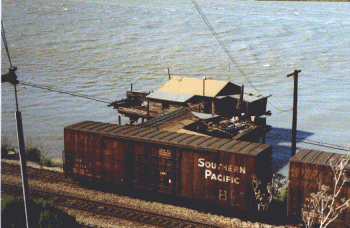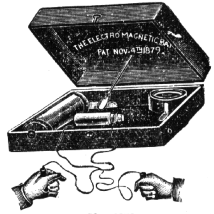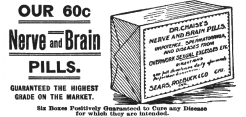

The impact of technology on the later part of the 19th century, was the primary cause for the conditions from which Futurism, and it's long list of successors, arose. It has only been about one hundred and fifties years for example, since the average person living in the rural and frontier areas of the United States still commonly used two flint rocks to start a fire since commercially manufactured matches were still rare to obtain. A rapid change in the daily existence occurred to a large portion of the society which had previously maintained a near neolithic life style for millennia.
The crossing of countries by railroads, the personal automobile, the telegraph, telephone, electric light, the electrification of the home, phonograph, radio, etc. all appeared within a short period of time. New labor saving devices allowed for more spare time by the masses (time which in turn could be taken up by the new theme parks, entertainment devices, and newly created hobbies like camping). The average work week was reduced from 80 hours to 60 hours by 1870 and then to 40 hours by 1910. The invention of the electric light by Thomas Edison and the development of alternating current generation by Nikola Tesla (which made world wide electrification economically possible), caused tremendous social upheavals [1].
 In America, for a
time after the 1880's or so, cities were viewed as wholesome places to raise a
family. The American spirit had collapsed after Manifest Destiny was
attained. People who do not make it out of the Great Plains stagnated within
difficult economic depressions due to an old style agrarian economy that had
been rendered obsolete by the Mechanical Age. The wilderness became viewed by
social reformers as being wild, filled with beasts, diseases and criminals: an
environment which was dark, dangerous and inherently evil. The American Dream
had become the American Nightmare [2]. The cities on
the other hand were viewed as being well-lit, full of the modern conveniences
which separated man from beast, and were filled with intellectual
accomplishments and wonders of civilization.
In America, for a
time after the 1880's or so, cities were viewed as wholesome places to raise a
family. The American spirit had collapsed after Manifest Destiny was
attained. People who do not make it out of the Great Plains stagnated within
difficult economic depressions due to an old style agrarian economy that had
been rendered obsolete by the Mechanical Age. The wilderness became viewed by
social reformers as being wild, filled with beasts, diseases and criminals: an
environment which was dark, dangerous and inherently evil. The American Dream
had become the American Nightmare [2]. The cities on
the other hand were viewed as being well-lit, full of the modern conveniences
which separated man from beast, and were filled with intellectual
accomplishments and wonders of civilization.
Individuals living with these beliefs,
broke out in a sort of mental rash, commonly known as American
nervousness or neurasthenia. This psychological disorder was a kind
of 'nerve fatigue' in accord with a popular economic view of times on how the
nervous system worked. An individual had a certain finite amount of nervous
energy which could be dissipated as a fluid by 'unwholesome' practices leaving
the individual enfeebled and afflicted with a number of ailments associated
with weakness. Since 'nervous fluid' was considered to be the same as
electricity, one of the cures for American nervousness was an electrical shock
which could revitalize the nervous system.  Both Thomas Edison [3]
and Nikola Tesla [4], built and sold devices which
exploited the supposed medicinal properties of electricity. Outbreaks of
American nervousness became prevalent shortly after the Civil War and the
disease went more or less extinct by the end of the twenties.
Both Thomas Edison [3]
and Nikola Tesla [4], built and sold devices which
exploited the supposed medicinal properties of electricity. Outbreaks of
American nervousness became prevalent shortly after the Civil War and the
disease went more or less extinct by the end of the twenties.
Several American writers such as Theodore
Dreiser, William James, and Henry Adams suffered from this illness. Also a
politician or two, the most famous being Theodore Roosevelt
[5]. He had suffered from insomnia, stomach trouble,
and asthma throughout his life. When he was first elected to the New York
legislature in 1880, he dressed in very dandified clothes and spoke with an
exaggerated accent in a high pitched voice. The local news papers of the times,
referred him 'as our own Oscar Wilde.' He was also referred to as 'Punkin-Lily'
and a 'Jane Dandy.' Such depictions partially led to his loss of reelection in
1884. As a cure, he went out West for a while to 'attain a state of manliness.'
He did things like hunt buffalo, invest in a cattle ranch, hike with John Muir,
and live a strenuous outdoor life whenever possible. 
Roosevelt's cure was the standard for males with American nervousness, for females it was the exact opposite: complete bed rest. As Roosevelt bluntly stated it: The first requisite in a healthy race is that a woman should be willing and able to bear children just as men must be willing and able to work and fight. The question of role had become confused by the impact of technology upon the home and society as a whole. American nervousness was a technological disease: a social situation had been created through rapidly changing technologies which made people sick.
The succeeding collapse of space by the telegraphy, telephone and radio made electricity the ultimate symbol of speed. For the Italian Futurists, electric light was 'holy' and it shows up as an object of veneration in their paintings. F. T. Marinetti had contemplated calling his movement Electricismo. He also said that there was really no need for Futurism in America, since it was already beyond Futurism. He suggested that American cities should be the models of art which the Italian Futurists emulate.
The American writer, Henry Adams in his autobiographical diary, The Education of Henry Adams (1900), has a chapter titled 'The Dynamo and the Virgin.' Though it laments the fact that men now worship machines more than the goddess/virgin it echoes many sentiments that are reminiscent of Marinetti:
Among the thousand symbols of ultimate energy, the dynamo was not so human as some, but it was the most expressive. In these seven years man had translated himself into a new universe which had no common scale of measurement with the old. He had entered a supersensual world, in which he could measure nothing except by chance collisions of movements imperceptible to each other, and so to some known ray at the end of the scale. The Woman had once been supreme... She was Goddess because of her force; she was the animated dynamo; she was reproduction -- the greatest and most mysterious of all energies; all she needed was to be fecund. An American Virgin would never dare command; an American Venus would never dare exist.[6]
Marinetti embraced the same impulse but glorified it with statements such as the following:
Let the reign of holy Electric Light finally come, to liberate Venice from its venal moonshine of furnished rooms [7]; and...we are developing and proclaiming a great new idea that runs through modern life: the idea of mechanical beauty. We therefore exalt love for the machine, that love we notice flaming on the cheeks of mechanics scorched and smeared with coal. You surely must have heard the remarks that owners of automobiles and factory directors commonly make: motors, they say, are truly mysterious... They seem to have personalities, souls, or wills. Hence we must prepare for the imminent, inevitable identification of man with motor... This nonhuman and mechanical being, constructed for an omnipresent velocity, will be naturally cruel, omniscient, and combative [8]
References:
1. David E. Nye, Electrifying America: Social Meanings of a New Technology, 1880-1940 (Cambridge, MA: The MIT Press, 1991).
2. A particularly disturbing depiction of this point of view, can be found in Michael Lesy's Wisconsin Death Trip (New York: Pantheon Books, 1973). A collection of photographs and newspaper clippings cataloging cases of suicide, epidemics, insanity, infanticide, and general high weirdness in the isolated farming community of Black River Falls, Jackson County, Wisconsin between the years of 1885 to 1900.
3. Robert Conot, Thomas A. Edison: A Streak of Luck (New York: Da Capo, 1979).
4. Margaret Cheney, Man Out Of Time (New York: Dorset Press, 1981). Throughout his life Tesla was also a firm believer in the therapeutic value of what he called "cold fire," both for refreshing the mind and cleansing the skin. p. 74.
5. Tom Lutz, American Nervousness 1903: An Anecdotal History (Ithaca: Cornell University Press, 1991).
6. Henry Adams, The Education of Henry Adams (New York: The Literary Classics, 1983), pp. 1067-1070.
7. F. T. Marinetti, Let's Murder the Moonshine: Selected Writings, translated by R. W. Flint and Arthur A. Coppotelli (Los Angeles: Sun & Moon Classics, 1991), p. 63.
8. Ibid, p. 98.